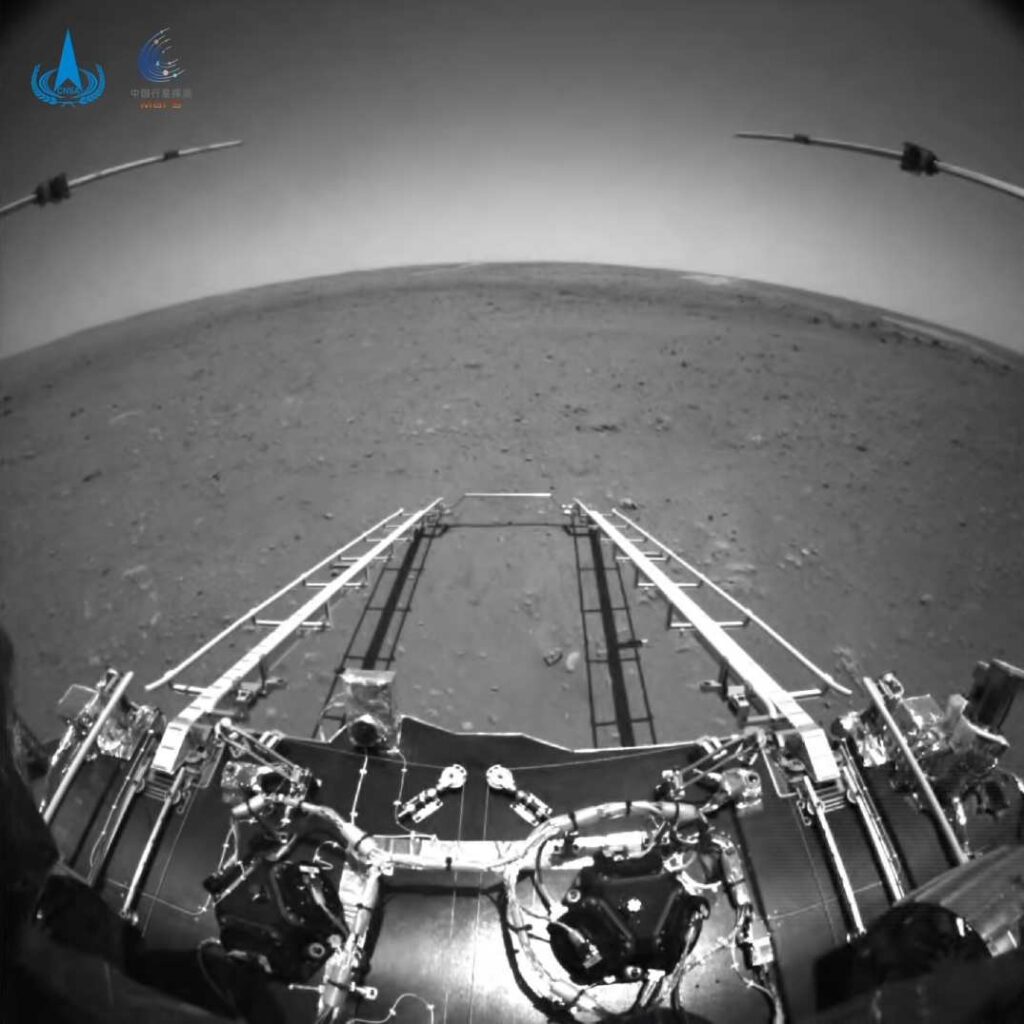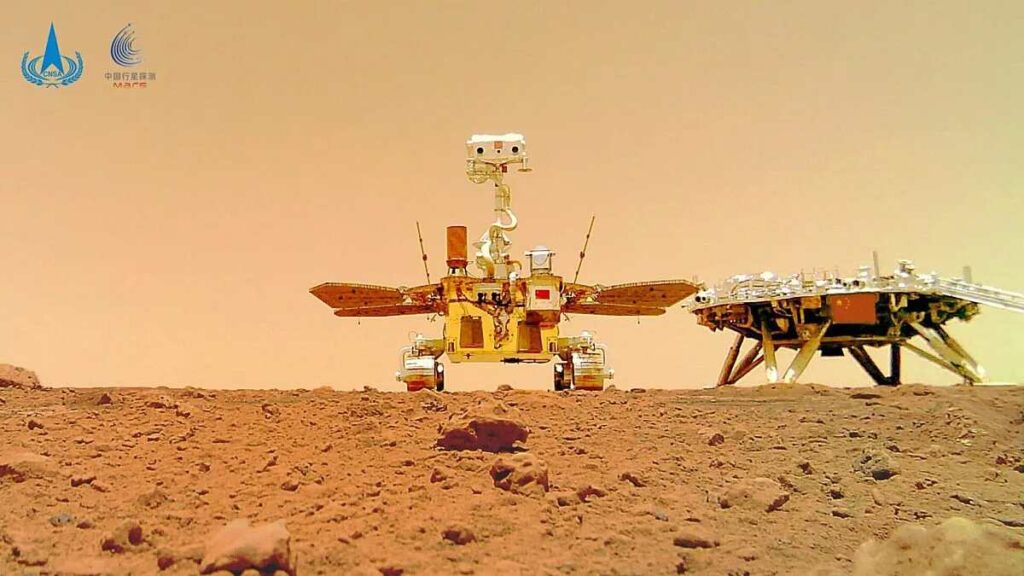Mars is a fascinating planet. Earth’s next-door neighbour, visible in the night sky if you look closely enough. The Space race, that started with sending man to the moon, has now shifted its attention to the red planet, Mars. NASA, ISRO, CNSA all have Mars Missions currently underway, with Elon Musk going as far as saying he is highly confident SpaceX will have humans on Martian surface by 2026. Our focus here though, is CNSA’s Tianwen-1 mission, whose lander successfully touched down in the Mars Utopia Planitia on May 14, 2021.
Background
The seeds for China’s Tianwen-1 mission were sown in 2012, following the same path mapped by the Chinese-Russian partnership for the Fobos-Grunt mission. Fobos-Grunt, the Russian spacecraft, was originally destined for Mars and Phobos and carried Yinghuo-1 which would have been the first Chinese Mars orbiter had the mission been successful. However, after reaching the initial Earth parking orbit, Fobos-Grunt’s primary propulsion unit failed to boost the spacecraft with the Fobos-Grunt and Yinghuo-1 stack subsequently re-entering Earth’s atmosphere marking the end of that mission.

China then started working on an independent mission to Mars, with Tianwen-1 being formally approved in 2016. Tianwen-1 has been designed as a three-pronged project comprising of an orbiter, a lander and a rover named Zhurong. Being the CNSA’s first interplanetary mission, Tianwen-1 is instrumental to Chinese authorities as a demonstration of their interplanetary travel capabilities. Additionally, this mission serves as a technology demonstration for the proposed Chinese mission to return samples of the Martian surface to Earth. Although the sample-return mission is scheduled for the 2030s, success of Tianwen-1 will play a key role in convincing Chinese as well as worldwide space agencies and authorities of CNSA’s prowess.
Current Status
Tianwen-1 travelled for seven months after its launch on July 23, 2020 before entering Martian orbit in February, 2021. Performing a series of calculated engine burns, the spacecraft managed to decelerate just enough to be caught by Mars’ gravitational pull. The spacecraft spent the next two months in a highly eccentric orbit, studying the planets surface to identify the most suitable landing zone for the lander and Zhurong rover.

On 14 May 2021, China wrote itself into history books as the third country to touch down on Martian surface. The lander, which contained the Zhurong rover bore most of the responsibility of safely landing the rover on Mars. The entire process had to be automated to near perfection considering radio communication between Earth and Mars took about 18 minutes in accordance with the distance between the planets at that time. By May 19, Chinese authorities released images of Zhurong moments after landing which depicted the rover in the process of moving from the lander onto the surface of Mars. The images show that, while Zhurong had already deployed its solar panels, it was still perched on the lander. The orbiter continues to remain in orbit around Mars and serves as a relay for communication between the Zhurong rover and Earth.

The landing architecture was considerably different from NASA’s tried-and-tested Skycrane method used for their Perseverance and Curiosity rovers. That said, CNSA’s techniques can be considered relatively intuitive and efficient. The lander capsule consisting of the rover was encased in a heat-resistant aeroshell during the lander’s initial approach. This aeroshell helped manage the heat generated by atmospheric entry as the lander approached Mars after separating from the orbiter. Since the entire process was automated, the parachute was deployed after a predetermined period of time to reduce the lander’s velocity once it had entire the Martian atmosphere. In the final phase of the landing procedure, the lander along with Zhurong breaks away from the aeroshell and parachute on a rocket-powered bench that performed a set of precise manoeuvres that safely placed the lander on the ground.
What is Zhurong’s mission?
Zhurong has since begun its 90 Sol mission which includes five scientific objectives set by Chinese space agencies. Those include studying the geological structure and historical evolution of the surface of Mars while also looking at the underground layers of soil. Further study must also be conducted on the atmosphere, particularly the ionosphere of Mars, the climate and seasonal variations that occur on the planet. Understanding soil composition and studying water ice distribution is also a key objective. Another aim is one that’s been a part of every Mars Mission till date, to search for evidence of current and past life on the planet.

Tianwen-1 also had alternative purposes as previously mentioned. It serves as a demonstration of technology that validates China’s deep space communication capabilities and gives a welcome boost to the anticipated sample-return mission planned for the 2030s. Zhurong is already setting into motion a part of the plan for this sample return mission as it has been tasked with collecting rock and soil samples for future retrieval. The orbiter, too, enables Chinese Space Agencies to locate a suitable cache site so that the future mission can easily collect the cached samples.
Whether or not we ever find evidence of life on Mars, we seem destined to make our way to the red planet. For better or for worse, Mars is the closest planet to Earth that could be considered habitable. There’s already sufficient evidence indicating Martian soil contains extractable water. The planet receives sufficient sunlight for solar panels to be used as a source of energy while also having an atmosphere (considerably thin) that could protect from solar radiation. The duration of a day, too, is comparable to Earth’s, with a Sol on mars being 24 hours and 39 minutes. Life on Mars would be unconventional and rather unnerving, but the barrage of missions directed towards Mars indicates that having humans on Mars isn’t a distant future. Tianwen-1 has made its mark on interplanetary travel, compounding credibility of our ability to travel to Mars.

